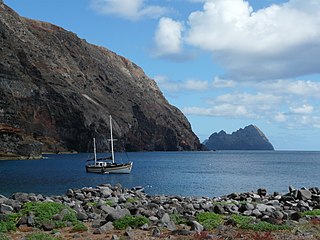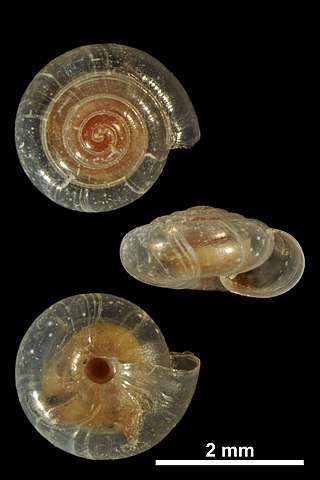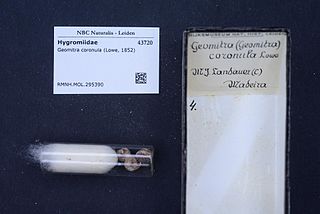
The Desertas Islands are a small archipelago in the Atlantic Ocean, part of the larger Portuguese Madeira Archipelago.

Helicidae is a large, diverse family of western Palaearctic, medium to large-sized, air-breathing land snails, sometimes called the "typical snails." It includes some of the largest European land snails, several species are common in anthropogenic habitats, and some became invasive on other continents. A number of species in this family are valued as food items, including Cornu aspersum the brown or garden snail, and Helix pomatia. The biologies of these two species in particular have been thoroughly studied and documented.
Atlantica gueriniana is a species of small air-breathing land snail, a terrestrial gastropod mollusk presently in the family Gastrodontidae, but formerly in Discidae, the disk snails.

Plebecula anaglyptica is a species of land snail in the family Geomitridae.

Caseolus abjectus is a species of land snail in the family Geomitridae, the hairy snails and their allies. It is endemic to Madeira, where it occurs on three islands in the archipelago.
Leiostyla is a genus of small air-breathing land snails, terrestrial pulmonate gastropod mollusks in the family Lauriidae.
Lemniscia galeata is a species of air-breathing land snails, terrestrial pulmonate gastropod mollusks in the family Geomitridae, the hairy snails and their allies.
Disculella spirulina is a species of gastropod in the Geomitridae family.
Spirorbula squalida is a species of air-breathing land snails, terrestrial pulmonate gastropod mollusks in the family Geomitridae, the hairy snails and their allies.

Gastrodontidae is a family of air-breathing land snails, terrestrial pulmonate gastropod mollusks in the superfamily Gastrodontoidea.

Vallonia pulchella, common name the lovely vallonia, is a species of very small air-breathing land snail, a terrestrial pulmonate gastropod mollusk in the family Valloniidae.

Vitrea contracta, the milky crystal snail, is a species of small, air-breathing land snail, a terrestrial pulmonate gastropod mollusk in the family Pristilomatidae.
Geomitra grabhami is a species of air-breathing land snail, terrestrial pulmonate gastropod mollusks in the family Geomitridae.

Janulus is a genus of air-breathing land snails, terrestrial pulmonate gastropod mollusks in the family Gastrodontidae.
Atlantica is a genus of snails in the family Gastrodontidae.

Craspedaria coronula is a species of air-breathing land snail in the genus Geomitridae.
Canaridiscus is a genus of air-breathing land snails, terrestrial pulmonate gastropod molluscs in the family Discidae, the disk snails.









